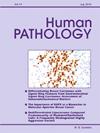Systemic ALK-negative anaplastic large cell lymphoma: Insights into morphologic, immunophenotypic, genetic and molecular characteristics
IF 2.7
2区 医学
Q2 PATHOLOGY
引用次数: 0
Abstract
Anaplastic large cell lymphoma (ALCL) is a mature T-cell neoplasm characterized by large pleomorphic cells, often with horseshoe- or kidney-shaped nuclei and abundant cytoplasm (hallmark cells), and uniformly strong CD30 expression. Based on ALK expression or ALK rearrangement, ALCL is further classified into ALK-positive (ALK+) and ALK-negative types. This review focuses on the clinicopathologic, immunophenotypic, cytogenetic and molecular features of systemic ALK-negative ALCL. These patients are usually older adults who present with advanced stage disease and often a poor prognosis. ALK-negative ALCL is morphologically indistinguishable from the common pattern of ALK+ ALCL, but some cases show non-common morphology, such as “donut cells”, Hodgkin-like features. ALK-negative ALCL is often negative for T-cell antigens (so-called “antigen loss”) and in some cases can have a “null” immunophenotype and be confused with other hematopoietic and non-hematopoietic neoplasms. Recurrent genetic/molecular alterations have been identified in systemic ALK-negative ALCL, including rearrangements of DUSP22, TP63, JAK2, FRK, MYC, ROS1 and TYK2; mutations of JAK1, STAT3 and MSCE; and aberrant expression of ERBB4. Some of these alterations may have prognostic significance and/or provide potential therapeutic targets. Data support the idea that ALK-negative ALCL with DUSP22 rearrangement is a distinctive variant due to its unique morphologic, immunophenotypic and molecular features. Gene expression profiling data have shown that ALK-negative ALCL has distinctive molecular signatures, different from ALK+ ALCL and other T-cell lymphomas. Better understanding of the morphologic, immunophenotypic, genetic and molecular features of ALK-negative ALCL will help establish the correct diagnosis, guide therapeutic strategies and improve patient outcomes.
全身性 ALK 阴性无细胞大细胞淋巴瘤:对形态学、免疫表型、基因和分子特征的深入了解。
无性大细胞淋巴瘤(ALCL)是一种成熟的T细胞肿瘤,其特点是细胞呈大的多形性,通常具有马蹄形或肾形的细胞核和丰富的细胞质(标志细胞),CD30表达一致强。根据ALK表达或ALK重排,ALCL又可分为ALK阳性(ALK+)和ALK阴性两种类型。本综述主要介绍全身性ALK阴性ALCL的临床病理学、免疫表型、细胞遗传学和分子特征。这些患者通常是老年人,疾病处于晚期,预后通常较差。ALK阴性ALCL在形态上与常见的ALK+ ALCLL无异,但有些病例表现出非常见的形态,如 "甜甜圈细胞"、霍奇金样特征等。ALK 阴性 ALCL 常为 T 细胞抗原阴性(即所谓的 "抗原丢失"),在某些病例中可出现 "空 "免疫表型,并与其他造血和非造血肿瘤相混淆。在全身性ALK阴性ALCL中已发现了复发性遗传/分子改变,包括DUSP22、TP63、JAK2、FRK、MYC、ROS1和TYK2的重排;JAK1、STAT3和MSCE的突变;以及ERBB4的异常表达。其中一些改变可能具有预后意义和/或提供潜在的治疗靶点。数据支持这样一种观点,即具有DUSP22重排的ALK阴性ALCL因其独特的形态学、免疫表型和分子特征而成为一种独特的变异。基因表达谱数据显示,ALK阴性ALCL具有独特的分子特征,不同于ALK+ ALCL和其他T细胞淋巴瘤。更好地了解ALK阴性ALCL的形态、免疫表型、遗传和分子特征将有助于确立正确诊断、指导治疗策略并改善患者预后。
本文章由计算机程序翻译,如有差异,请以英文原文为准。
求助全文
约1分钟内获得全文
求助全文
来源期刊

Human pathology
医学-病理学
CiteScore
5.30
自引率
6.10%
发文量
206
审稿时长
21 days
期刊介绍:
Human Pathology is designed to bring information of clinicopathologic significance to human disease to the laboratory and clinical physician. It presents information drawn from morphologic and clinical laboratory studies with direct relevance to the understanding of human diseases. Papers published concern morphologic and clinicopathologic observations, reviews of diseases, analyses of problems in pathology, significant collections of case material and advances in concepts or techniques of value in the analysis and diagnosis of disease. Theoretical and experimental pathology and molecular biology pertinent to human disease are included. This critical journal is well illustrated with exceptional reproductions of photomicrographs and microscopic anatomy.
 求助内容:
求助内容: 应助结果提醒方式:
应助结果提醒方式:


